Let’s talk about your business card—that important branding tool that’s often someone’s first impression of your brand. Beyond the must-haves, such as your logo and contact details, your business card is your brand’s introduction, where creativity meets professionalism. In this article, we’ve listed the best business card design ideas for different industries, helping you to choose card dimensions, shapes, materials and trends relevant to your specific business needs. Read on for business card inspiration tailored to your industry.
We chatted with Mark LaRosa, Creative Manager at Vista, for his insights on business card design. Mark’s expert tips will help you find a unique look for your business card based on what industry you’re in.
- Creative professionals can design cards using bold visuals, innovative materials and premium textures.
- To convey competence and build trust, business professionals should use minimalist, refined and simple business card layouts.
- Service providers should use eco-friendly materials and clear visuals on their business cards, while retail and hospitality businesses can lean on premium finishes, warm tones and playful elements.
- Business card ideas for fitness businesses include high-contrast, bold colors and interactive elements.
- Businesses in the beauty and wellness industries benefit from on-trend typography and gloss finishes.
Business card design ideas for every industry
Creative professionals
If you work in the creative industry—maybe you’re a photographer, florist or graphic designer—showcase your creativity on your business card with interesting shapes, bold typography and premium textures. “Your business card represents you as a professional freelancer or a small agency, not a large company. So, choose a card design that captures your unique style, personality and talent,” Mark says.
“Your business card represents you as a professional freelancer or a small agency, not a large company. So, choose a card design that captures your unique style, personality and talent.”—Mark LaRosa, Creative Manager at Vista
For business card inspiration for creative professionals, Mark suggests:
- Creating a repeating background using your logo to add depth to your business card background.
- Including something about working with you, or simply a “hello” with a personality-packed tagline.
- Showing off your talent with a recent project or a client testimonial.
“Whether it’s the logo you’ve designed or a catchy line of copy that summarizes your skills, this is your first introduction and a chance to showcase your expertise—so put it front and center,” Mark says.
If you want your business card to be as creative as your industry, consider the following business card ideas.
1. Miniature artwork cards
Turn your business card into a mini canvas or sketchpad, showcasing your creativity. Every card is a piece of art, and therefore a branded marketing tool that tells potential clients what you’re capable of.

Source: Business card idea for a creative by no ame via Behance
2. Unconventional material cards
To make a memorable first impression, tailor your business card material to your industry, profession or brand. For example, fashion designers, upholsterers and craft businesses might use fabric or linen business cards, echoing the materials they work with, while musicians and DJs could opt for cards made from vinyl. Artists and sculptors might design business cards crafted from lightweight, durable clay or even miniature canvases.
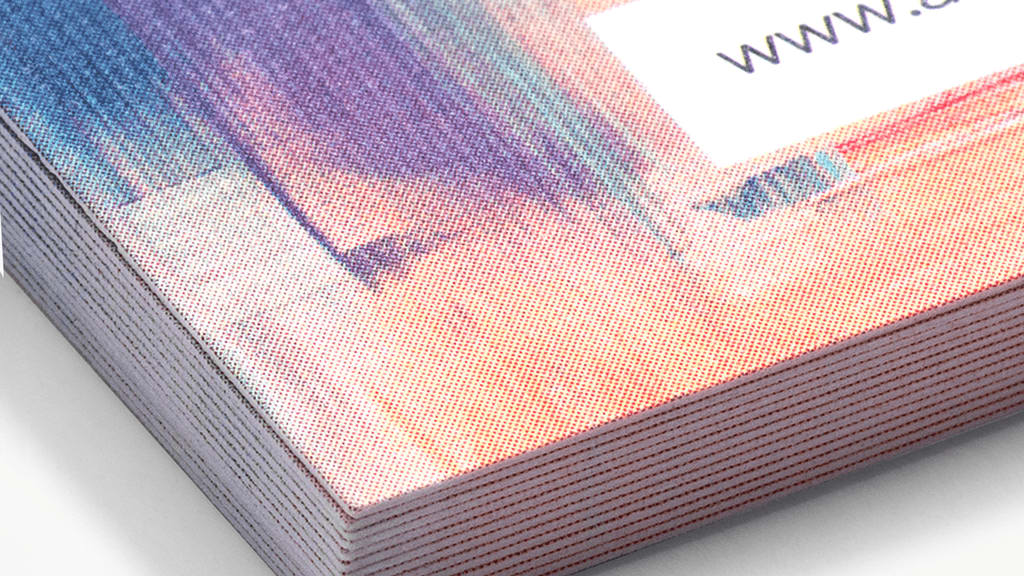
3. Bold fonts and colors
As a creative professional, your business cards must reflect your creative flair. Opting for business card designs that are bright, funky and even a bit daring can effectively showcase your individuality. Showcase your creativity with bold fonts and colors.
For more on business card design, read our guide on how to design a business card.
Business professionals
For professional businesses, like a law firm or real estate agency, competence and professionalism are the most important things to communicate with your card. Business professionals should accomplish this using minimal and refined design layouts over eye-catching creative touches.
Mark LaRosa says business professionals should avoid playful typography, sticking to more conservative font pairings instead. Use geometric shapes and pastel colors for understated ways to add personality to a more conservative business card design.
When printing, keep content inside the safe zone (typically ~0.125″ inset) so cropping never trims your art, and export at 300 DPI in CMYK for predictable color.
4. Transparent cards
Imagine a business card made of clear or frosted plastic instead of paper. This innovative material choice is modern and sure to grab attention. Plus, plastic business cards are a great way to communicate transparency in business.
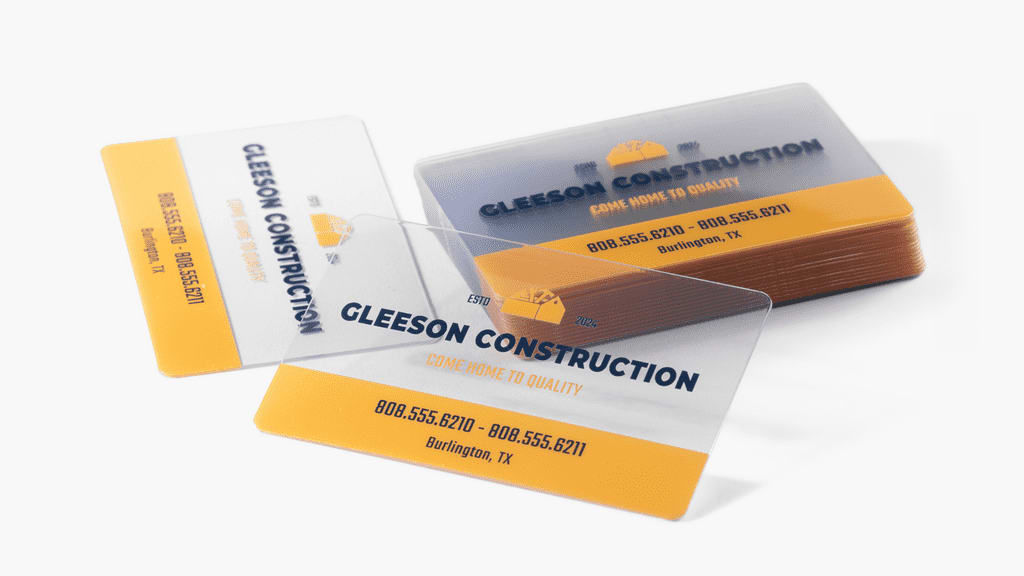
5. Two-tone minimalism on thick matte card
A minimalist two-tone palette with ample white space and simple typography communicates reliability. Pair these simple design choices with thick matte card stock to project sophistication and professionalism.
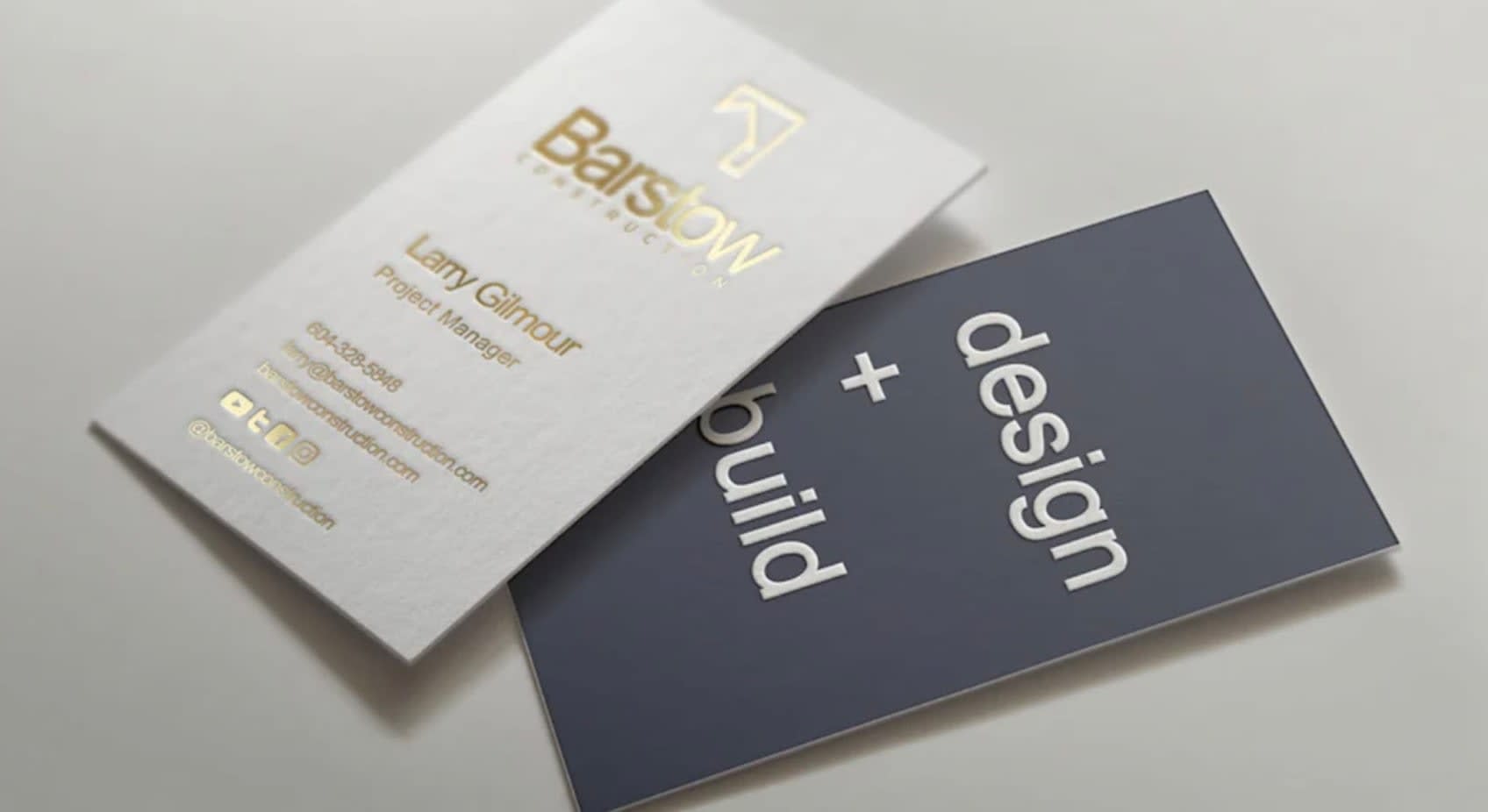
Source: Business card design by ultrastjarna via 99designs by Vista
Explore different business card stock and materials to ensure you choose the right paper for your cards.
6. Simple typography
Use a classic sans serif or a clean serif font in just one or two weights with generous spacing. Print text in charcoal or navy on thick matte stock and consider subtle embossing on the logo for sophisticated tactility.
7. Headshot business card
In client-facing roles, like real estate and legal professions, a high-resolution, tasteful headshot business card builds trust and shows the person behind the business. Print on thick matte or soft-touch card stock to resist scuff marks and use a clean keyline or subtle border to keep the portrait crisp and professional.

Source: Professional business card design idea with a headshot via VistaCreate
Service providers
For service providers, like a housekeeping company or landscaping business, business cards should clearly communicate what you do. For example, if you’re in the business of making things clean and beautiful, your business cards should be sleek and tidy. “But that doesn’t mean it needs to be a stark white card,” Mark says. “Your card should always clearly state what you do, but also let your clients know what’s different or unique about you.”
8. Kraft or recycled stock and green accents
Use kraft, bamboo or recycled paper stock and green accents to showcase your commitment to sustainability or communicate your eco-friendly brand values without sacrificing clarity.
Eco-friendly business cards made from recycled paper resonate with environmentally conscious clients and business partners.
9. One-line USP or tagline
Add a single icon (e.g. leaf for landscaping, squeegee for cleaning) and a short tagline like “Bonded & insured, 24-hour response” or a one-liner that sums up your brand identity, story and values.

10. Back-of-card service list
Use the reverse of your business card for a simple list of the services you provide. Uncoated or recycled paper stocks make writing on business cards easy.
Personal trainers and fitness industries
Health and fitness is a broad and competitive industry, so personal trainers and fitness professionals want their business cards to stand out. Vista’s Mark LaRosa recommends showcasing your specific area of expertise. “If you focus on strength training or physical conditioning, consider an expressive logo and bold color palette to communicate a sense of power and definition.”
However, if your area of expertise is a restorative practice, like yoga, soft colors and natural textures can help communicate the relaxing effects of your classes.

Mark also suggests including customer testimonials on the back of your business card. “These details prove your ability in your field, instill confidence and increase the likelihood of recommendations.”
If using a testimonial on your card, keep it under 20 words to preserve type size and legibility.
11. Stretchable rubber cards
Imagine a business card made of a stretchable material similar to a resistance band or yoga mat. It’s not only a unique business card idea, but also directly relates to fitness, and therefore is aligned with your industry.

Source: A business card design for a personal trainer via Pinterest
12. Fitness equipment-shaped cards or imagery
A business card shaped like a dumbbell or any other fitness equipment can be a fun way to remind clients of your services. Unique-shaped cards are more memorable, helping your brand stick in minds.

Incorporate aspects of your business or industry to make your card stand out. For fitness or gym businesses, try incorporating a small, achievable fitness challenge or workout routine on the card, or adding a simple, paper fitness tracker or goal checklist, encouraging potential clients to start their fitness journey.
Retail businesses
Style and trends drive retail business—especially if you’re in the fashion or design industry. “If your business card looks outdated, potential clients will assume your whole aesthetic is old and stale,” Mark says. “Stay modern, stay current, but choose styles that appeal to most clients.”
“If your business card looks outdated, potential clients will assume your whole aesthetic is old and stale. Stay modern, stay current, but choose styles that appeal to most clients.”—Mark LaRosa, Creative Manager at Vista

13. Raised foil and metallic accents
Raised foil or metallic business cards add an elegant touch without adding clutter to your card’s layout. Businesses, particularly jewelry, beauty and luxury brands, can use metallic accent logos for a premium look.
14. Square business cards as packaging inserts
For retail brands, square business cards can double up as mailer box inserts, mini tags and personal thank-you notes inside packaging. Whatever their use, unique business card dimensions make cards more memorable.

15. Soft-touch finish
Soft-touch finishes reduce glare in store lighting and feel fabric-like, aligning with brand storytelling for clothing businesses. The subtle tactility of soft-touch makes cards feel more premium.

16. Product-related shapes, cut-outs or line drawings
Lean into the product you sell with unique shapes, tactile die-cuts or simple line drawings. For example, a cheese shop might punch a few circular holes into its business card to look like Swiss cheese, turning a basic rectangle into a persuasive and original branding tool.
Restaurant or eatery
Whether you run a coffee shop or pizza parlor, Vista’s Mark LaRosa says your business card design should demonstrate what makes you different.
When deciding how to design business cards for your restaurant, “remember, people might be picking up business cards in your restaurant, receiving them in a hotel lobby or getting them from a friend as a recommendation. So, it pays to capture the memorable aspects of your eatery on your card.”
“Remember, people might be picking up business cards in your restaurant, receiving them in a hotel lobby or getting them from a friend as a recommendation. So, it pays to capture the memorable aspects of your eatery on your card.”—Mark LaRosa, Creative Manager at Vista
17. Rewards or loyalty card
Turn the back of your business card into a loyalty card, where customers can collect stamps with every visit.
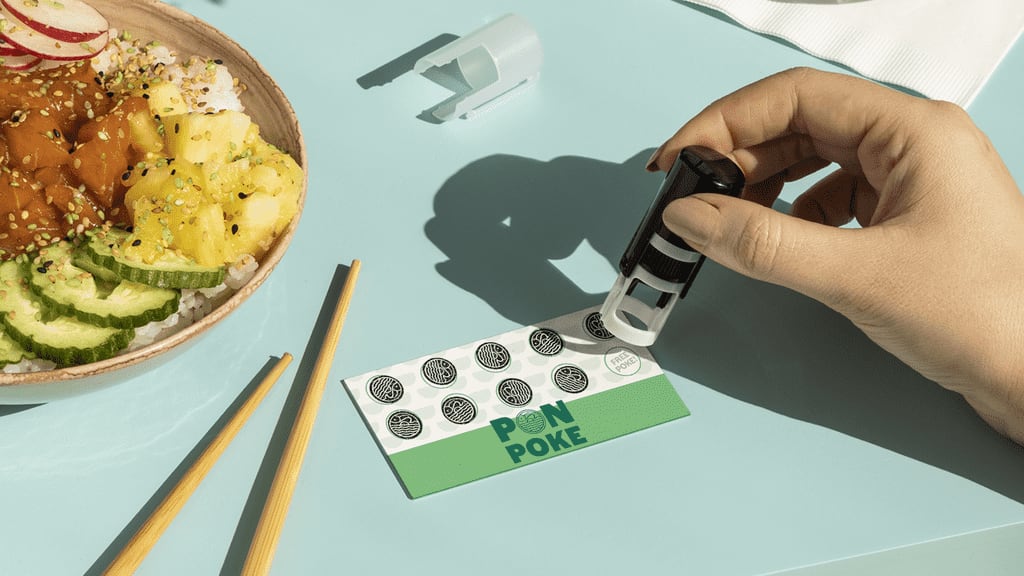
18. QR code business card
QR code business cards allow restaurants and eateries to easily direct customers towards websites, online menus or ordering pages.

If adding a QR code to your card, make sure you test it at the final size and ensure high contrast.
19. Edible business cards
Offer a novelty, food-safe edible card (e.g. printed sugar sheet or chocolate wrapper insert) that literally leaves a taste of your brand. Edible business cards are a perfect giveaway for events and promotions.
20. Natural look with kraft paper stock
Do you use locally sourced or organic ingredients? For vegan and sustainable restaurants, choose kraft stock with simple dark inks to signal local or organic. Lean into the uncoated, tactile feel and use high-contrast typography. Add a restrained green accent or a small icon to reinforce your sustainability brand values.
Beauty and wellness
Beauty and wellness business cards should communicate your specialization. Are you a cutting-edge salon that specializes in the latest trends? List your specialties, but don’t overdo the text and clutter the design.
“Much like other creative professions, beauty-related professions involve original artistry,” Mark LaRosa says. “Communicate that you’re up-to-date with the latest styles by using a clear layout and on-trend typography.”
Use the back side of your card for listing treatments and styles. Or add a QR code that clients can scan to make an appointment!
21. Spot gloss and UV finishes
Use a clean, minimalist business card layout with on-trend typography, then add a delicate spot gloss or UV finish for a premium look. This subtle shine echoes the glossy finish of healthy hair and nails, is tactile and stands up well to frequent handling in busy salon settings, reinforcing your brand as polished and professional.
22. Appointment reminder or swatch card
Use the back of your business card as an appointment reminder to reduce no-shows. Beauty brands can even use the reverse as a swatch card for customers to test out different products on.

23. Highlight your brand personality
If you run a day spa, use your business card to give potential clients an idea of your spa’s vibe. Show that you use all-natural ingredients with a kraft paper card or reflect your luxurious brand identity with silver foil text.
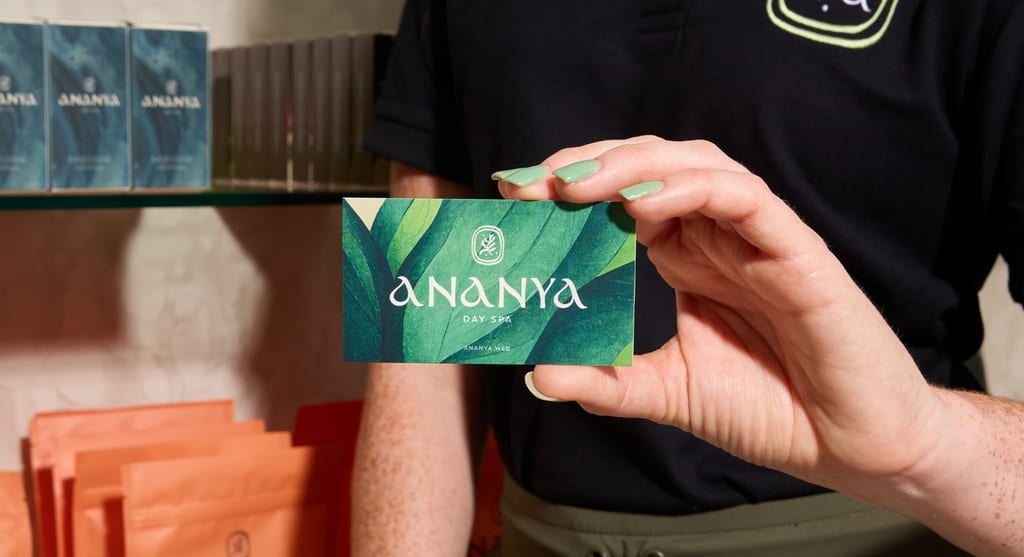
If you’re still looking for business card inspiration, check out our list of unique business cards and ensure your card stands out from the crowd.
You have your perfect business card idea, now what?
First, follow the rules of business card design so that your card works hard for your brand. Then be sure to stay on-brand. Your business card is a mini ambassador of your brand and should sing in harmony with your brand identity, values and personality. Whether your visual identity is minimalist and chic or bold and funky, your business card design should be a seamless extension of your brand.
Next, make sure your card resonates with your target audience. Are they corporate contacts who appreciate sleek sophistication? Or creative souls who seek a splash of color and innovation? Tailoring your design to appeal to your audience’s tastes and expectations is key.
Keeping a finger on the pulse of business card trends can give your card a cutting-edge advantage. Whether it’s sustainable materials, QR technology or augmented reality features, staying up to date with the latest trends sets you apart from the crowd.
Finally, your card should deliver your message loud and clear. Even in the digital age, the importance of business cards remains—they’re not just a piece of paper, but a communication tool. Every element, from fonts to material choice, should contribute to the story you want to tell, whether that’s professionalism and trust or creativity and innovation.
When you’re ready to print, run a small test print and review at 100% size under daylight and warm indoor light. Check legibility at arm’s length, scan QR codes on multiple devices and double check the trim, bleed and safe zone before placing the full order.
Business card design ideas FAQs
How should a business card be designed?
Start with the essentials: your name, job title, company name, logo and contact details. Then, design your card to reflect your brand’s visual identity. Keep the text clear and easy to read, and use high-quality materials to communicate professionalism. Business card templates are a great place to start with card design.
What is the best layout for a business card?
The best business card layout idea is clean, balanced and visually appealing. Place your logo at the top or center, keep the text aligned for easy readability and leave enough white space to prevent clutter. Use the back of the card for additional information, like a tagline, services or appointment reminders.
How can I make my business card stand out?
Use eye-catching elements like bold colors, unique materials (like transparent or textured cards) or creative shapes. Adding interactive features like QR codes or including a memorable tagline can also help your card leave a lasting impression.
What is the best way to format business cards?
Choose between standard business card dimensions (typically 3.5 x 2 inches) or attention-grabbing circle, leaf or square cards. Choose legible fonts, ensure proper alignment and use contrasting colors for text and backgrounds. Avoid overloading cards with information—keep the design clear and focused.


























